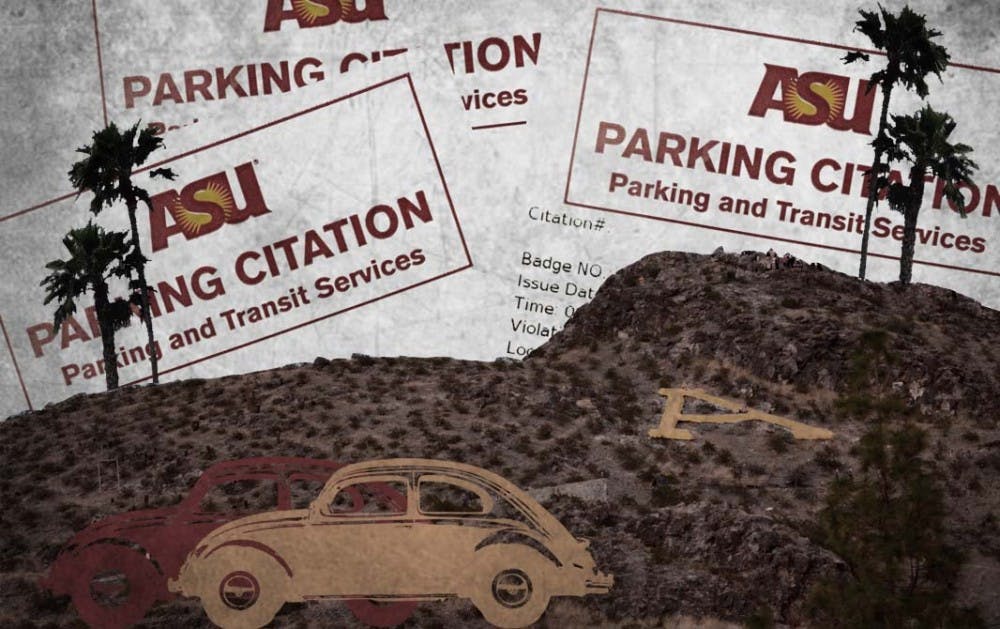ASU Parking and Transit Services gave out 59,199 citations on ASU campuses last year in 2017 — that's the equivalent of over half of ASU's student population getting ticketed.
Those tickets, which can range from a few dollars to a few hundred for multiple offenses, generated $906,000 revenue for the department in fiscal year 2017.
To analyze trends in where most citations occur, The State Press compiled a map of all citations written in campus parking lots by enforcement officers over the past three years.
The lots that accrued the most tickets annually are in west Tempe. More than 14,000 tickets were given at Lot 20 on the corner of University and Mill Ave, and the same amount was given at the lot outside of the Sun Devil Bookstore, Lot 27.
Half of the department’s $26 million budget in fiscal year 2017 comes from selling annual parking permits to students and day passes to visitors, according to Parking and Transit Services director Melinda Alonzo. Daily and hourly parking costs make up 39 percent and parking citations account for 3 percent.
The department receives no money from the University or from students’ tuition.
“Parking revenue pays for everything, including the entire parking staff, the operations, the paper clips, the shuttles, any of the vehicles we provide,” Alonzo said. “We are completely self supporting.”
In August 2017, Parking and Transit Services increased its maximum daily parking rate for the first time in a decade from $12 per day to $15 per day — a 25 percent increase.
David King, an ASU assistant professor of Geographical Sciences and Urban Planning who studies transportation policies such as parking management, said raising parking prices is necessary to reduce traffic.
“Parking should be constrained, and it should be paid,” King said. “That’s not to say there shouldn’t be any parking, but parking is a scarce resource and the price should reflect that.”
Alonzo said the parking increase will bring in an extra $700,000 in revenue each year. This extra revenue will go toward covering an increase in the cost of the intercampus shuttles, which are operated by Silverado Stages, a contractor, she said.
And documents obtained by The State Press show the hourly rate for operating the shuttles increased from $78.65 to $90 in September 2017.
“Our cost for the (shuttle contract) this coming year is three quarters of a million dollars higher more than it was in the last 18 months we were operating,” Alonzo said.
Parking and Transit Services gives around 300 citations and warnings on an average weekday, Alonzo said, but not all of the citations result in a fee.
Two years ago, Parking and Transit Services started the “give me a break” program which allowed first time offenders to be let off with a warning.
“That is our way of being educational and not punitive,” Alonzo said.
Parking and Transit Services also offers an appeals process for students who feel they were cited unfairly.
Alonzo said if a student accumulates more than $160 worth of citations, Parking and Transit Services will give the student a warning and a week to resolve the citations. After that, the student will be notified by email and a notification will be left on the car that it is in risk of being booted.
“If you’re towed from campus, you really have ignored a lot,” Alonzo said.
According to the Parking and Transit Services’ Rules and Regulations, students who fail to pay outstanding citations can receive penalties such as salary withholding, termination of employment and even suspension.
The department is also planning on building a $25 million parking structure on an existing lot on the southeast corner of Mill Avenue and University Drive.
The structure, referred to as block 27, is anticipated to house around 1,200 cars, Alonzo said.
The department is also developing a new license plate-recognition program to make ticketing more efficient, Alonzo said.
With the new program, people will purchase permits or day passes using their license plates. An officer using a scanner will go through the parking lots and scan license plates to check if the owner of the vehicle has paid for that parking spot.
“Initially, there will probably be a little bit of a rise of citations because we’ll catch a few more people, but then that’s what happens — compliance,” Alonzo said. “Students realize ‘I can’t park in that lot because I’ll get caught.’”
Click or tap on the maroon lots below to see how many violations were documented in those areas on ASU's Tempe, Downtown Phoenix, West and Polytechnic campuses.
Reach the reporter at sgarg32@asu.edu or follow @sanjana_garg1 on Twitter.
Database created by: James Quigley, Chuck Dries, Stella Atzenweiler and Reilly Kneedler.
Graphic designed by Stella Atzenweiler.
Like State Press on Facebook and follow @statepresss on Twitter.



